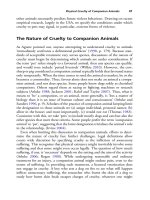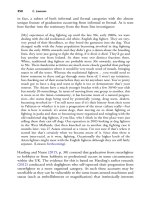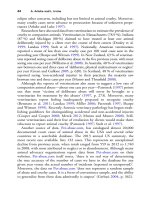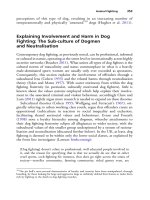The palgrave international handbook of a 178
Bạn đang xem bản rút gọn của tài liệu. Xem và tải ngay bản đầy đủ của tài liệu tại đây (25.37 KB, 1 trang )
170
E. Cudworth
with farmed animals might be transformed back to a model of ‘animal
husbandry’ wherein farmers have a work relationship with animals based on
ties of community and of reciprocity wherein animals are not reduced to
objects of production but understood as living and sensate co-producers
(see 2014, pp. 10–15). In this model of domestication, there is reciprocity
and recognition between humans and the domesticate species they work
with. Porcher makes light of arguments for animal liberation and the end of
the use of animals for food (2014, pp. 60–64), portraying a world of
unnatural food and unnatural species separation and ultimately, the abolition of domesticate animals. This is a pity because she and those such as
Nibert, Torres or Safran Foer share an analysis of the violences of industrial
animal food production for the billions of animals bred and raised for
killing and those humans working in such noxious systems.
Given that my own work is very much informed by feminist work in
animal studies, I am very wary of seeking an original moment of fall (such as
does Nibert with his conception of domesicration), or of return to the past
which may (according to Porcher) involve collaborative rather than abusive
relations between species. Feminist theory has much to say about the problems attending a search of origins of forms of abuse, such as gender
domination, and same applies to a search for ‘origins’ in the domination
and oppression of non-human animals. My own attempts to explain the
abuse of farmed animals draws particularly the idea of intersectionalised
oppressions (Cudworth 2011). This means I would look at the abuse of
farmed animals in terms of various kinds of relational systems of power in
addition to capitalism, gender, ‘race’ and so on as well as looking at the ways
social hierarchies of species which privilege human beings are sustained and
reproduced over time.
I use the term ‘anthroparchy’ to describe and explain a social system, a
complex and relatively stable set of hierarchical relationships, in which the
incredible diversity of non-human species are homogenised as ‘animals’,
identified as part of ‘nature’ and dominated through formations of social
organisation which privilege the human. Anthroparchy involves different
degrees of dominatory power: oppression, exploitation and marginalisation.
Different oppressive forms apply to different species due to their specific
characteristics and normative behaviours such as the presence of sociality and
the ways in which this presents itself. Thus for the active chicken or the
gregarious pig, the terms ‘dull’, ‘barren’ or ‘lonely’ life are accurate descriptors of the lives of these farmed animals, whereas these terms would not be
applicable descriptors for the lives of the bacteria living on the effluvia from
pig and chicken farms. Exploitation refers to the use of some being as a









